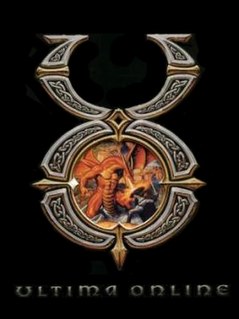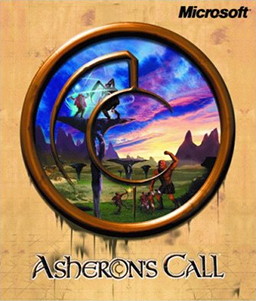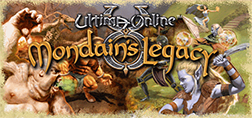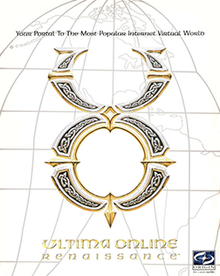
Ultima is a series of open world fantasy role-playing video games from Origin Systems, Inc. Ultima was created by Richard Garriott. The series is one of the most significant in computer game history and is considered, alongside Wizardry and Might and Magic, to be one of the establishers of the CRPG genre. Several games of the series are considered seminal entries in their genre, and each installment introduced new innovations which then were widely copied by other games. Electronic Arts owns the brand.

Ultima Online (UO) is a massively multiplayer online role-playing game (MMORPG) released on September 24, 1997 by Origin Systems.

Asheron's Call (AC) was a fantasy MMORPG for Microsoft Windows PCs, developed and published by Turbine Entertainment Software. Though it was developed by the Turbine team, it was published as a Microsoft title until 2004. The game was set on the island continent of Dereth and several surrounding smaller islands and archipelagos on the fictional planet of Auberean. The game was played in a large seamless 3D virtual world which could host thousands of players' characters at a time.

Ultima X: Odyssey was to be a massively multiplayer online role-playing game (MMORPG) based in the Ultima universe, developed by Origin Systems for Electronic Arts.

City of Heroes (CoH) is a massively multiplayer online role-playing game which was developed by Cryptic Studios and published by NCSOFT. The game was launched in North America on April 28, 2004, and in Europe by NCsoft Europe on February 4, 2005, with English, German and French servers. In the game, players created super-powered player characters that could team up with others to complete missions and fight criminals belonging to various gangs and organizations in the fictional Paragon City.

Ultima Online: Age of Shadows is the fifth expansion pack for the popular MMORPG Ultima Online. It was released on February 11, 2003 and was the last title by developer Origin Systems.

Ultima, later known as Ultima I: The First Age of Darkness or simply Ultima I, is the first game in the Ultima series of role-playing video games created by Richard Garriott, originally released for the Apple II. It was first published in the United States by California Pacific Computer Company, which registered a copyright for the game on September 2, 1980 and officially released it in June 1981. Since its release, the game has been completely re-coded and ported to many different platforms. The 1986 re-code of Ultima is the most commonly known and available version of the game.

Ultima II: The Revenge of the Enchantress, released on August 24, 1982 for the Apple II, is the second role-playing video game in the Ultima series, and the second installment in Ultima's "Age of Darkness" trilogy.

Ultima VI: The False Prophet, released by Origin Systems Inc. in 1990, is the sixth part in the role-playing video game series of Ultima. It is the third and final game in the "Age of Enlightenment" trilogy. Ultima VI sees the player return to Britannia, at war with a race of gargoyles from another land, struggling to stop a prophecy from ending their race. The player must help defend Britannia against these gargoyles, and ultimately discover the secrets about both lands and its peoples.

Ultima VII: The Black Gate is the seventh installment of the Ultima series of role-playing video games, released on April 16, 1992. In it the player returns as The Avatar, a would-be paragon of moral virtue who faces down many dangers and deceptions in order to cleanse the medieval fantasy world of Britannia of assorted plots and schemes, monster infestations, and the undermining of crown authority.

Ultima IX: Ascension is the ninth and final part of the main series of the role-playing video game series Ultima. Developed by Origin Systems and published by Electronic Arts, Ultima IX was released in 1999 for Microsoft Windows after years in development hell. Following the Avatar's escape from Pagan, he is transported back to Britannia for one final battle with the Guardian, who is increasingly ruining the physical and moral fabric of that land by use of eight columns. The Avatar must fight his way to the runes of virtue found in each of the columns, and cleanse them in the shrines of Virtue, then face off against the Guardian himself.

Ultima VII Part Two: Serpent Isle is a role-playing video game released in 1993 as part of the core Ultima series, its story beginning eighteen months after the conclusion of Ultima VII: The Black Gate. In Serpent Isle, the Avatar follows Batlin to the eponymous land called Serpent Isle, finding three city-states founded by those who left Britannia generations before and ancient ruins from a still-older lost civilization that was there long before them.

Ultima Online: The Second Age was the first expansion for the Ultima Online MMORPG. The expansion added several features to the game, including a new region called the Lost Lands, new creatures, and support for player-built cities.

Dungeons & Dragons Online (DDO) is a massively multiplayer online role-playing game (MMORPG) developed by Turbine for Microsoft Windows and OS X. The game was originally marketed as Dungeons & Dragons Online: Stormreach, then renamed Dungeons & Dragons Online: Eberron Unlimited upon switching to a hybrid free to play model, and was finally rebranded Dungeons & Dragons Online, with the introduction of Forgotten Realms-related content. Turbine developed DDO as an online adaptation of Dungeons & Dragons (D&D), originally based loosely on the D&D 3.5 rule set. The game is set on the unexplored continent of Xen'drik within the Eberron campaign setting, and in the Kingdom of Cormyr within the Forgotten Realms campaign setting.

Mondain's Legacy is the seventh expansion to the Ultima Online MMORPG, featuring a new playable race, elves, along with a new skill and several new dungeons. This expansion focused content more on existing and veteran players, rather than trying to draw new players. It was also the first UO expansion to only be available via digital download instead of the traditional retail box.

Ultima Online: Stygian Abyss is the eighth expansion pack for the 1997 MMORPG Ultima Online. The expansion was announced prematurely on the Japanese Ultima Online website. It was originally slated for release in the summer of 2007, but expected after 2008. On August 12, 2009, the official release date of September 8, 2009 was announced by Electronic Arts.
Dragon Saga called Dragonica pre-2010, is a free-to-play 3D side-scrolling massively multiplayer online role-playing game developed by Barunson Interactive and Gravity Interactive. Development has been ongoing since March 2006. Operation of Dragon Saga is relegated to different publishers for their respective regions. Whilst being free-to-play, the game also includes a cash shop that allows for unique customization of player's characters. The game's commercial launch was on June 2009 in China and October 2009 in Europe and October 2010 in North America. Characters created during the Open Beta testing were carried over to the commercial release.
A database shard is a horizontal partition of data in a database or search engine. Each individual partition is referred to as a shard or database shard. Each shard is held on a separate database server instance, to spread load.

Europa Universalis IV is a grand strategy video game in the Europa Universalis series, developed by Paradox Development Studio and published by Paradox Interactive. The game was released on 13 August 2013. It is a strategy game where players can control a nation from the Late Middle Ages through the Early modern period, conducting trade, administration, diplomacy, colonization and warfare.

Guild Wars 2: Heart of Thorns is the first expansion pack for Guild Wars 2, a massively multiplayer online role-playing game developed by ArenaNet and published by NCSOFT. It was released for Microsoft Windows on October 23, 2015. It was made available for pre-purchase on June 16, 2015. After the release date was broadcast on August 29, 2015, the base game was made free-to-play, although free players have fewer character slots and have restrictions on mailing and chatting with other players.


















